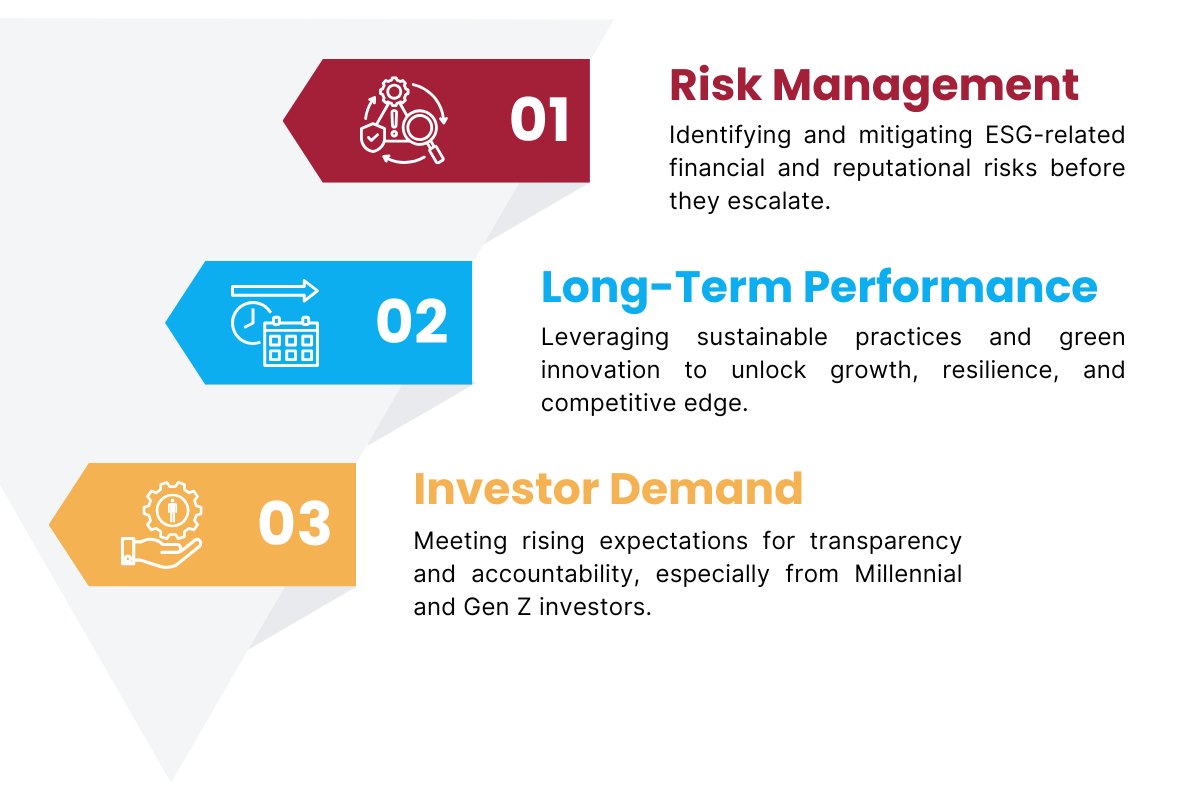In this article, you'll discover why ESG reporting is a natural extension of FP&A responsibilities and...

In today's dynamic world, businesses are constantly struggling with many uncertainties, from geopolitical pressure and macroeconomic instability to pressure to keep up with Artificial Intelligence. Amidst all this, companies and investors are realising that true success extends beyond just the bottom line. This success is driven by three letters: ESG — Environmental, Social, and Governance, a set of standards to assess a company's sustainability efforts and societal impact.
To build a sustainable, long-term business, ESG must be at the forefront of all financial decision-making, influencing everything from investor mindset to investment portfolios. This article will explore the connections between ESG and Financial Planning & Analysis (FP&A). We will also examine the benefits of having clear ESG Targets, the role of responsible sourcing, and how ESG factors influence investment strategies.
The "Environment" part of ESG is all about a company's impact on the planet. It's a comprehensive approach that starts with its own business and goes all the way through its entire supply chain. The focus is to mitigate climate change by actively reducing emissions, also known as decarbonising operations, and closely watching energy consumption. This commitment goes beyond a company's front door. It means taking responsibility for the whole value chain by working with suppliers on their science-based targets. By doing this, everyone involved is working towards the same environmental goals, which is how a company can truly reduce its overall carbon footprint.
The "Social" pillar of ESG is about building an inclusive culture where employees feel seen, heard, and valued. This kind of environment not only leads to employee retention and engagement but also fosters innovation and loyalty and creates high-performing teams. Similarly, AI plays a pivotal role in enhancing both internal and external social values. It helps eliminate mundane tasks and focus on more strategic and high-impact work. This makes employees' jobs more meaningful and drives the entire company forward.
Finally, "Governance" focuses on how a company operates. It involves leadership oversight and direction, diversity of the board of directors, executive pay, audits, shareholders' rights, and protecting Intellectual property. Additionally, as AI is becoming more common, we also need to consider the scale of autonomy granted to AI systems and develop a compliance framework for data Governance & Protection.
ESG and FP&A: Driving Shared Value
FP&A teams are a core pillar of any organisation's success. They have a key role in improving a company's value through revenue generation, cost optimisation, and capital structure. FP&A's role has expanded to a broader landscape of driving long-term value across the organisation, focusing on non-financial success metrics. ESG and its relationship with FP&A have become more mature with changing times. Almost every aspect of a company's operations, from resource consumption to employee well-being and supply chain ethics, has an environmental, social, or governance impact. This impact affects revenue, expenses, and capital investments, making it a significant focus area for FP&A. Let's discuss the role of FP&A in detail:
Quantifying ESG impacts: FP&A can assign financial values to non-financial metrics like Supplier Diversity, Carbon Footprint, GHG emissions, and waste generation to enable better decision-making. For example, investing in energy-efficient machinery might have an upfront cost, but FP&A can project long-term savings in reduced carbon taxes & utility bills. In a recent project, I focused on building a tool to track Scope 3 and Supplier emissions. These emissions are responsible for a company's operation but are not produced by the company or its owned assets. This visual dashboard gives leadership a clear idea of our progress towards climate goals and allows them to make intelligent and informed decisions that truly drive impact and sustainability.
ESG Reporting: FP&A teams are perfectly set up to take the lead in ESG Reporting efforts, as they're already pros at gathering data, analysing, and putting together clear reports.
Forecasting ESG-related risks and opportunities: FP&A teams are uniquely positioned to predict the risks and opportunities linked to ESG. For instance, they can spot potential problems like supply chain disruptions from extreme weather. On the other hand, FP&A can also build financial models to show the potential profits from investing in long-term and sustainable R&D.
How ESG Factors Shape Investment Strategies
ESG factors are now fundamental tenets in analysing investments; they're no longer optional "good-to-haves." More and more investors are recognising that companies with strong ESG (Environmental, Social, and Governance) practices are more agile, resilient, better managed, and more likely to succeed in the long run. Let's explore in detail.

Risk Management: ESG factors help identify potential financial risks, such as reputational damage, before they become big problems. This can help investors avoid pitfalls and make resilient choices while building a good brand reputation.
Long-term Performance: Businesses with strong ESG practices are more likely to attract investors and demonstrate better long-term financial performance. Investing in clean and green products is not just good for the planet but also leads to new market opportunities, giving them a competitive edge over others.
Investor Demand: Investors, especially Millennials and Gen Zs, are now prioritising transparency and accountability around ESG issues, leading to a shift towards more responsible capital investments and compliance.
We have discussed how ESG factors shape investment strategies. Now, let's see how companies are putting these principles into action, influencing the bottom line and building positive impact through Responsible sourcing, an ethical and socially conscious way of procurement.
Here's Responsible Sourcing in Action:
Autodesk states that it "is committed to sourcing 100% renewable energy to cover its facilities, co-located data centers, and employees' home offices and neutralise residual carbon emissions for scopes 1, 2, and 3 annually, beginning FY21."
According to Nestlé, the company "aims for 100% of key ingredients volumes to be responsibly sourced by 2030. They ensure that their ingredients are traceable back to their origin, and the volumes Nestlé buys through its direct suppliers are compliant with its Responsible Sourcing Core Requirements at the production level, such as material that is traceable back to its origin."
It is also imperative that we support innovative solutions to build a sustainable future. For instance, my recent pro bono initiative involved building a digital presence via a website, videos telling their story, and CAD models for a company that aims to transform depleted oil and gas wells into renewable energy storage infrastructure. This project aimed to help them raise funding to achieve their decarbonisation mission from renewable baseload power.
In conclusion, ESG is no longer a peripheral concern but a core force driving financial performance and investment strategies, proving that we can pursue financial gains and meaningful purposes simultaneously.
This article is author's own and does not represent the views of Autodesk.
Sources
Autodesk Impact Report 2025
https://www.workiva.com/resources/what-is-esg-environmental-social-governance
https://www.ey.com/en_us/insights/consulting/fp-a-adding-long-term-business-value-with-evolving-role
https://www.gep.com/blog/strategy/responsible-sourcing-vital-for-supply-chain
Subscribe to
FP&A Trends Digest

We will regularly update you on the latest trends and developments in FP&A. Take the opportunity to have articles written by finance thought leaders delivered directly to your inbox; watch compelling webinars; connect with like-minded professionals; and become a part of our global community.






